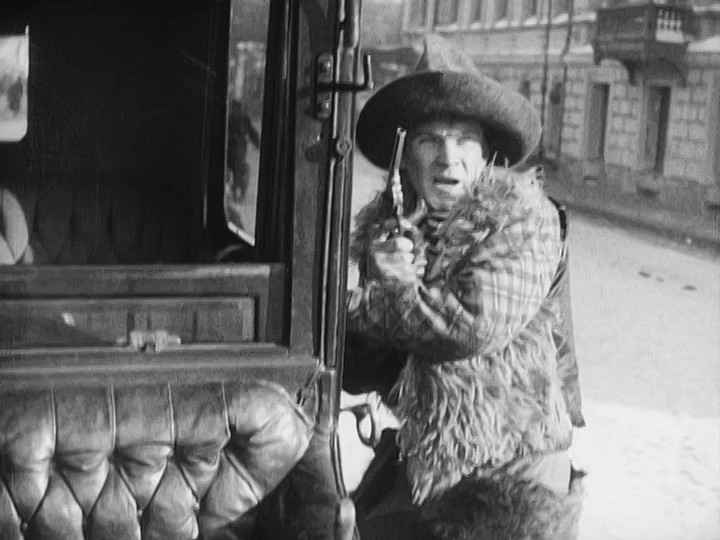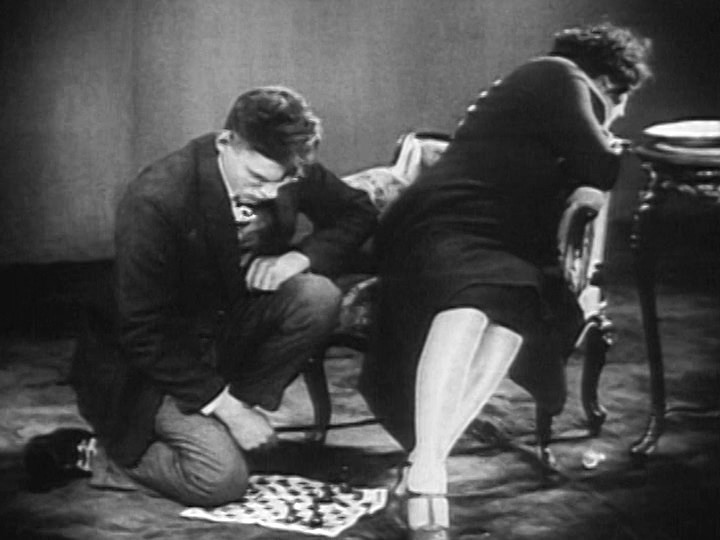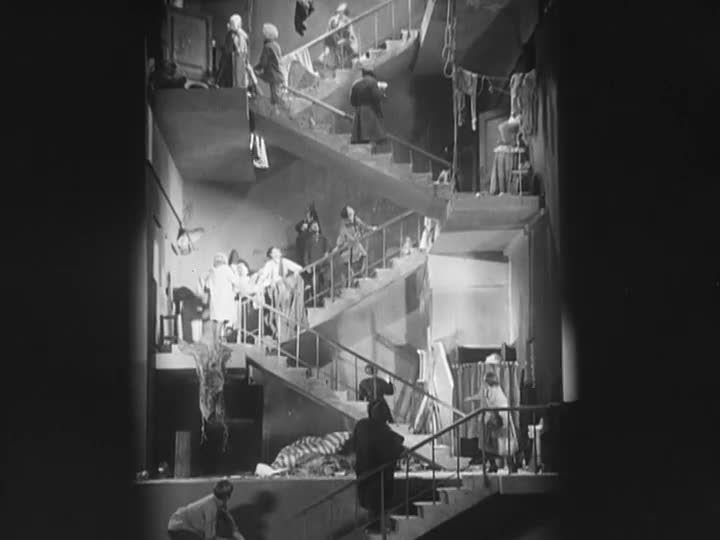Let’s face it, Soviet silent cinema isn’t renowned for its sense of humor. And that’s a shame.
Most of us were introduced to the silent era of Russian film through the dialectic exercises of Sergei Eisenstein, who combined the intellectual and the visceral in such films as Strike (1925) and Battleship Potemkin (1925) or the dazzling montage symphony that is Dziga Vertov‘s Man With a Movie Camera (1929). They are thrilling works with serious themes and a rigorous aesthetic and intellectual approach. But for all their celebration of the proletariat as the collective hero of the great Soviet experiment, the working men and women of the Soviet Union really just wanted to have fun at the movies and the most popular Russian films were indeed light entertainment and energetic comedies. They’ve merely been harder to find than the rousing celebrations of Soviet values and nationalistic displays of great communist victories, films elevated as standard bearers of the era of Soviet Formalism and the editing revolution, at least until recently. In fact, for a long time, the only widely seen example of Soviet comedy was Chess Fever (1925), a comic short spoofing the real-life chess obsession that swept Russia during the 1925 chess tournament in Moscow.
Co-director Vsevolod Pudovkin was one of Soviet cinema’s intellectual heavyweights, a theorist who apprenticed under filmmaking pioneer Lev Kuleshov and helped develop the theories of montage that guided formalist filmmaking in the twenties. He actually applies some of those ideas to this funny and clever short comedy about a chess addict who risks losing his fiancée in his chess obsession. Pudovkin went on to make such serious features as Mother (1926) and The End of St. Petersburg (1927) but Chess Fever is all lighthearted fun, a lark rather than a lesson. And it showed that Pudovkin’s brand of montage was also effective when it came to humor: the perfect cut was just as effective in delivering a punchline as pounding home a political point.
Then again, Pudovkin’s apprenticeship included co-writing and acting in The Extraordinary Adventures of Mr. West in the Land of the Bolsheviks (1924), the debut feature from Lev Kuleshov. Kuleshov started the Experimental Cine-Laboratory at the Moscow State Film Institute—often simply referred to as the Kuleshov Workshop—and he mentored such students as Pudovkin, Boris Barnet, and Sergei Eisenstein in the primacy of editing and graphic elements of image design and composition in the construction of cinema. The culmination of their study and experimentation (such as the famed “Kuleshov Effect” of meaning created through the juxtaposition of images) was not a high-brow drama, however. The first feature produced by Kuleshov and his students was The Extraordinary Adventures of Mr. West in the Land of the Bolsheviks, a veritable political cartoon of a comedy that borrows the energy and action and dynamic shot composition of American cinema and turns it back on its inspiration to spoof American stereotypes of “Bolshevik revolutionaries.”

Carefully constructed and designed with an eye toward the graphic properties of the image and action across cuts, it plays like a slapstick farce with agit-prop sets and Griffith-inspired crosscutting. Mr. West (Porfiri Podobed, dressed to evoke a middle-aged Harold Lloyd), an American politician on a fact-finding mission to the Soviet Union, arrives with star-spangled socks and a head full of the most sinister stereotypes of the barbarous state of the communist peoples. A gang of con artists play on his fears when they kidnap him and stage a “trial” that plays out likes a piece of political theater by way of a German Expressionist horror, all of it part of an elaborate plot to pry him from his money.
While Kuleshov and crew present the communist caricatures with a knowing wink to its Soviet audience, its equally absurd American clichés—West’s cowboy sidekick (played by future director Boris Barnet) arrives in Moscow in chaps and cowboy hat, shoots up the streets like a drunken cowhand, and lassoes a car like it was a runaway horse—are played for culture clash comedy: the crazy hayseed in the big city. By the end our wide-eyed Mr. West is introduced to the true face of communism and the glories of the Soviet ideal, but along the way Kuleshov creates a breakneck mix of chase film, cliffhanger adventure and slapstick comedy with cartoonish twists. It’s American popular entertainment refracted through a Soviet lens. It’s also very funny, highly inventive and quite knowing in its appropriation of cinema clichés.

Boris Barnet followed his mentor’s example and turned to comedy for his directorial debut. The three-part, four-and-a-half-hour serial Miss Mend (1926), co-directed with Feder Ozep, follows the adventures of Miss Vivian Mend (Natalya Glan), dedicated typist and heroic supporter of the working class labor movement, and her doting admirers turned action heroes. “The whole city seems to be in the grip of some gigantic criminal conspiracy,” observes a photojournalist who tracks the strange doings around the funeral of a millionaire industrialist back to The Organization, a capitalist cabal bent on world domination through chemical warfare and political suppression (part of their dastardly plan is, of course, the demonization of the Bolsheviks as international criminals).

Though modeled after the Douglas Fairbanks films and cliffhanger serials of Hollywood, the ruthless Dr. Mabuse-like villain and his devious campaign of murder, kidnapping, body-snatching, and bribery also recalls Louis Feuillade‘s Fantomas serials and Fritz Lang‘s Spies, only with cheeky humor and quirky characters. There are chases galore (on foot, in cars, on horseback), a stunning train wreck that leaves a mangled car with a body twisted in the wreckage (the villains coldly plant phony evidence on the corpse), fistfights, bombs, and plenty of vodka. With its tongue-in-cheek satire of American corruption, driving pace, dynamic compositions and busy action, this rapid-fire thriller was criticized by the Soviet authorities for its dubious values and western influences but it was embraced by the public who made it a smash hit.

The House on Trubnaya (1928), directed by Barnet just a couple years later, is hands down my favorite comedy from the silent era of Soviet cinema. This slapstick odyssey sends Paranaya (Vera Maretskaya, who looks like a Russian nesting doll in her bulky rural garb), a naive peasant worker from the provinces, to the big city where she is hired as a maid in a madcap rooming house and learns about the glories of unionization between comic adventures.
Barnet takes his camera to the streets to shoot scenes in the bustle of Moscow crowds and constructs a fabulous cutaway three-story rooming house set that introduces the melting pot of a community with a screen crammed with activity and sight gags and beats both Jerry Lewis (The Errand Boy) and Jean-Luc Godard (Tout va bien) by decades. It’s the opposite of the Kuleshov ideal of images streamlined to essential details and a very different aesthetic than Eisenstein’s layered designs. Barnet’s embrace of montage filmmaking is less about ideas than rhythm and momentum, often resorting to rapid intercutting merely to whip up energy. Yet at other times he constructs a visual poetry through movement and image, as in a prologue of the city waking up for the day. His montage of shots along empty trolley tracks creates a sense of movement with nary a train in sight, recalling Berlin: Symphony of a City and anticipating Vertov’s Man With a Movie Camera.
Finally, however, it’s a wild comedy filled with entertaining caricatures, inventive comic set-pieces, a narrative that playfully and cleverly bounces through time and between storylines, and a zippy style that tosses in slow-motion, freeze frames and reverse motion, all while maintaining a palpable affection for his kooky community. The obligatory lesson of collective responsibility is duly delivered as our doughy, dutiful Paranaya opens her eyes to the reality behind the socialist ideals and rises to the occasion to set things right. But Barnet sells the lesson by making political action look like great fun: Join “The Party” and join the party.
And finally there is The Cigarette Girl of Mosselprom (1924), a lightweight, fun-loving romantic comedy and the most popular Soviet-produced film of the silent era. Set on the bustling streets of Moscow, it stars Yuliya Solntseva (fresh from leading lady duties on the 1924 science fiction lark Aelita: Queen of Mars) as the lovely Zina, the cigarette girl of the title, as she is pursued by three suitors. An accountant, looking very much the nervous scholar in his trim mustache and cluttered office, buys a pack from her every day in Mosselprom Square, even though he doesn’t smoke (his collection is a shrine to his love for her). A young, handsome, and charming movie cameraman is immediately smitten when he spots her while scouting locations and invites her to audition for a new movie. An American fat cat capitalist on a business trip in Moscow falls for her while visiting the set. The story meanders through a somewhat arbitrary plot that sends Zina bouncing between the suitors while embarking on a career as a movie actress.
Along with the romantic confusion and slapstick comedy (most of it quite accomplished, all of it energetically executed) is a snapshot of the urban bustle and modern life of 1924 Moscow. Director Yuri Zhelyabuzhsky, who began as a cinematographer and continued to shoot his own films (no surprise that he favors the cameraman in this romantic quadrangle), takes the camera to the streets just like the company within the film. Solntseva, at least as seen here, is an unusual romantic lead, a pretty girl with a lovely smile, bushy eyebrows, and a shadow of mustache clearly visible in numerous shots. Not exactly the Hollywood brand of glamour photography (where she would certainly have been plucked and groomed to perfection), but then this isn’t a Hollywood romance, it’s a lark with spirited working-class heroes who actually look like real people. Sure, the two Russian suitors, proletariat workers both, risk their jobs and their lives for Zina while the rich, decadent American simply tries to buy her affections, but that’s as much of a political message the film offers. This is comedy, not communist dialectics.
In fact, The Cigarette Girl of Mosselprom was branded a “bourgeois comedy” and panned by Soviet film critics at the time for its western influences, which made it all the more embarrassing when it became the most successful Soviet-produced film of the silent era. Audiences flocked to this silly, politically regressive comedy, surely because it offered a bright, lively fantasy with affectionately-drawn characters and a happy ending for within the bustle of contemporary Moscow. It’s as close to a home grown sophisticated romantic comedy as Soviet cinema had to offer at the time.











